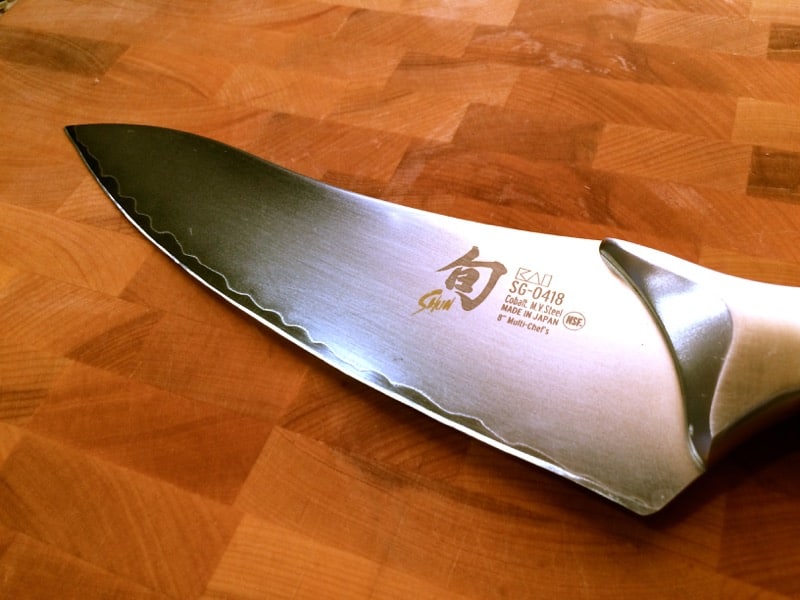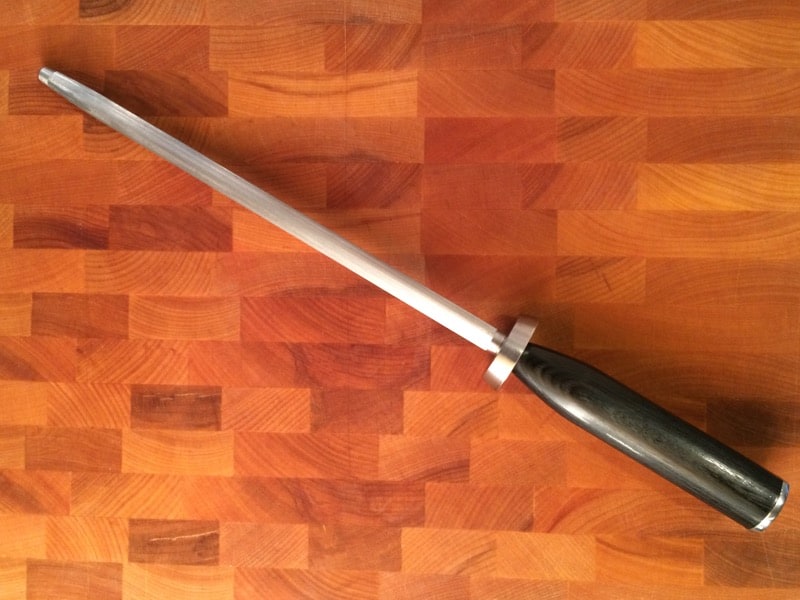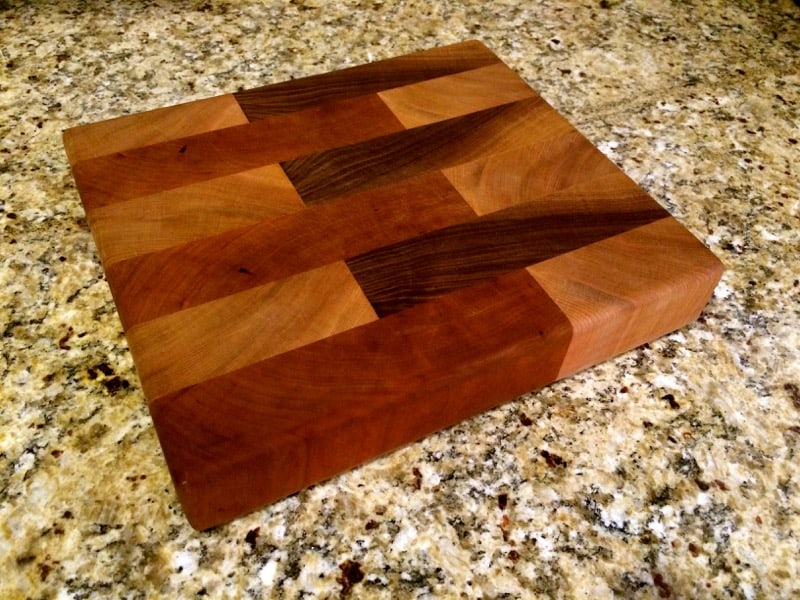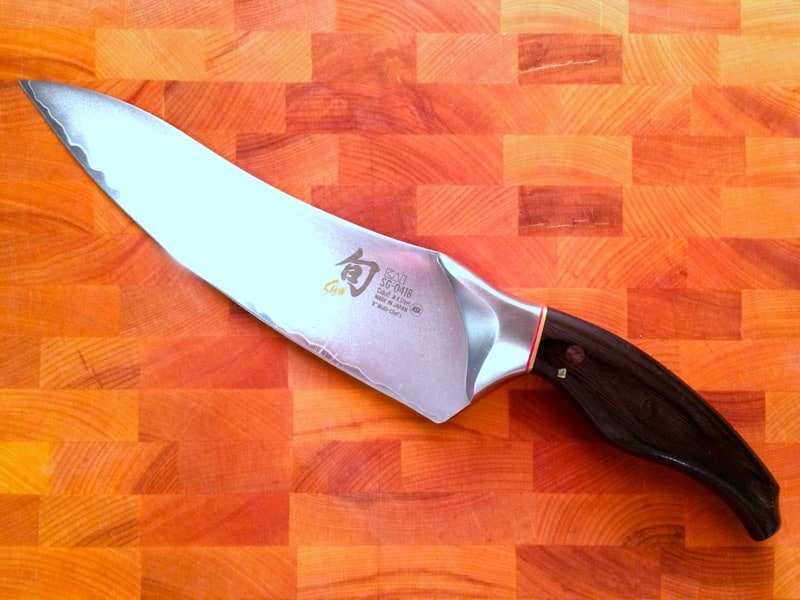
Japanese chefs believe our soul goes into our knives once we start using them – Masaharu Morimoto.
So today, to take care of these soulful tools that we so lovingly buy after much research and sometimes after leaving a big gaping hole in the pocket, Doug is giving us all a few very useful instructions on essential knife maintenance.
Doug blogs at The Kitchen Professor, and while his degree is honorary (bestowed upon him by his wife), he has enjoyed cooking his whole life. He loves using old cast iron, BBQ,and loves adding the small, special touch to a recipe that takes it from just “okay” to “wow.”
Doug Says :-
Using high-quality knives that are well maintained can make cooking even more enjoyable. I remember walking into Williams Sonoma to get my first “good” knife, like the ones I saw on the Food Network. It is a Wusthof Classic Santoku and I still have it after 10 years. In fact, it is my everyday knife and I even bring it with me on vacation.
My first knife had some tough times back when I didn’t know how to care for a knife but now I have a routine to keep my knives sharp and that will keep them in top shape for a long time to come.
Ongoing Maintenance
Use a Honing Steel
A honing steel is a great device to help keep your knives in top form, and it only takes a few seconds! A honing steel does not sharpen your knives (and if you have a knife sharpener, you certainly wouldn’t want to use it every day or even before every use).
A honing steel realigns the edge of your knife blade. We can’t see it with the naked eye, but if you were to magnify the edge of your knife after you use it, you would see that it looks a little jagged; using the honing steel realigns that jagged edge so it is super sharp!

These cylindrical rods are usually around a foot long, don’t take up much room in your kitchen, and are inexpensive compared to the benefit they provide.
I use this Shun honing steel because it has a nice angle guide on the edge of the handle guard. Plus, it goes along with my Shun Chef’s Ken Onion Chef’s knife very well.
Use a High Quality Cutting Board
It is important to protect the edge of your knife, and if you don’t use a cutting board and cut on any hard surface (like granite, glass, or even a ceramic plate), you can risk damaging the edge of your blade.
If your cutting board is wood, end grain is the easiest on the knife, but you could also look for composite or plastic cutting boards if you are looking for something that is dishwasher safe.

The end grain cutting boards are great to cut on and look beautiful since they showcase the structure of the wood. I bought the one pictured below from a furniture maker and woodworker in Stowe, Vermont a couple years ago. It was under $75 and one-of-a-kind. I expect it to last a lifetime so end grain boards are worth the investment.
Washing Your Knives
You should wash your knives by hand. It’s not the dishwasher soap, or even the heat that will harm your knives, it’s the fact that the knives will most likely be jostled during the cleaning and that can lead to damage.

Once you make it a habit to wash your knives by hand it will become part of your routine and won’t seem like a chore. Have a designated place on the counter where you leave your knife after using it (away from the edge) and always clean it first when you start doing the dishes.
Do not place your knife in the sink – you could lose track of it in the soapy water and cut yourself, or other objects could bump into the blade and damage it. Hand-dry your knives immediately after washing them and properly store them.
Storing Your Knives
If you haven’t figured it out by now, the most important way to care for your knives is to protect the knife blade! You should never just throw your knives into a vacant kitchen drawer – not only is it dangerous, it is bad for your knife blades.
Here are some safe options for storing your knife blades (in no particular order):
- Storage Blocks – You are probably familiar with the “knife sets” that come with a storage block. These blocks are a nice way to display your knives, and it sits handily on the counter within reach. On the con side, you can’t clean inside the block slots, and the block could slightly dull your knife as it bumps into the edge when you take it in and out.
- Magnetic Strips – A magnetic strip can be easily attached to a wall, and is easier to clean than a knife block. These handy little gadgets are inexpensive, and prominently display your knives while making them easy to reach. There are even magnetic strips that don’t look like metal at all (they look like wood) if you are interested in matching your kitchen décor.
- Knife Sleeves – These are exactly what they sound like – a snug sleeve for your knife that protects the blade and protects your fingers. A knife sleeve is absolutely essential if you are going to store your knives in a drawer. They are also great for traveling (I always take my favorite knives with me when I travel). If you are in a pinch and don’t have time to buy a commercial knife sleeve, you can make one yourself out of a cardboard cereal box (though you really should invest in a sturdier sleeve long term).
Sharpening Your Knife
If you do everything we’ve talked about thus far, your knife will still get dull over time. This is inevitable, and happens to even the highest quality knives with daily use. A sharper knife is a safer knife, because a dull blade takes more force to cut.
How often you need to sharpen your knives depends on the quality of your knife and how much you use it. In general, a few times a year should be enough.
Once you get used to using a sharp blade, you will be able to tell when it is getting dull. There are two main options for sharpening your knives (if you are going to do it yourself): electric sharpeners and manual sharpening systems.
Electric Sharpening Systems
Electric sharpeners are the fastest, most convenient, and easiest way to sharpen your knife, and with most systems you stick the knife in a slot and pull it through a few times. The downside to electric sharpeners is that most only sharpen to one angle.
I would recommend two models and the platform is nearly identical – Either the Chef’s Choice 15 Trizor XV or the 3-Stage Wusthof Electric Knife Sharpener. It really depends if you have a brand preference and your price point.
Here are reviews of each of those models: Review of the Trizor and the 3-Stage Wusthof Electric Sharpeners. These two sharpeners actually sharpen to 15º and 14º, respectively, so they are suitable for Asian style knives. As you could’ve guessed, the Wusthof is perfect for the Wusthof PEtec knives.
Here are more reviews of electric sharpeners if you need a fast way to sharpen your knives. If you have more time to dedicate, then you may want to look at manual sharpening systems.
Manual Sharpening Systems
The main benefit to a manual sharpening system is that you can sharpen to any angle you want. The downside is there is a slight learning curve with the equipment, and it takes much longer than an electric sharpener. My wife got me my first manual sharpening system, and I love it! I have the Gatco 10006 System – see my review here. I actually practice using it with a few inexpensive knives, so I was sure that I had the process down before starting with my expensive blades.
Conclusion
In summary, taking proper care of your knives will allow them to last longer and will also give you a safer kitchen!
It may seem like a lot at first, but once you incorporate a few tasks into your routine (honing, hand washing), invest in a few items (high quality cutting boards and storage), and periodically sharpen your blades, you will realize that your knife is your best friend in the kitchen, and will stay that way for many years to come.
Remember to…
- Use a cutting board made of wood, composite material, or plastic…Not cut on metal, glass, or granite.
- Wash your knives by hand…don’t let them get beat up in the dishwasher.
- Store knives properly…not loose in a drawer.
- Use a sharpening steel whenever you use your knives.
- Sharpen your most used knives whenever they need it – about once a quarter.
References
Thanks Dough. It was wonderful to have you write this very useful post. And you get brownie points for choosing shun knives. They are my absolute favorites!

